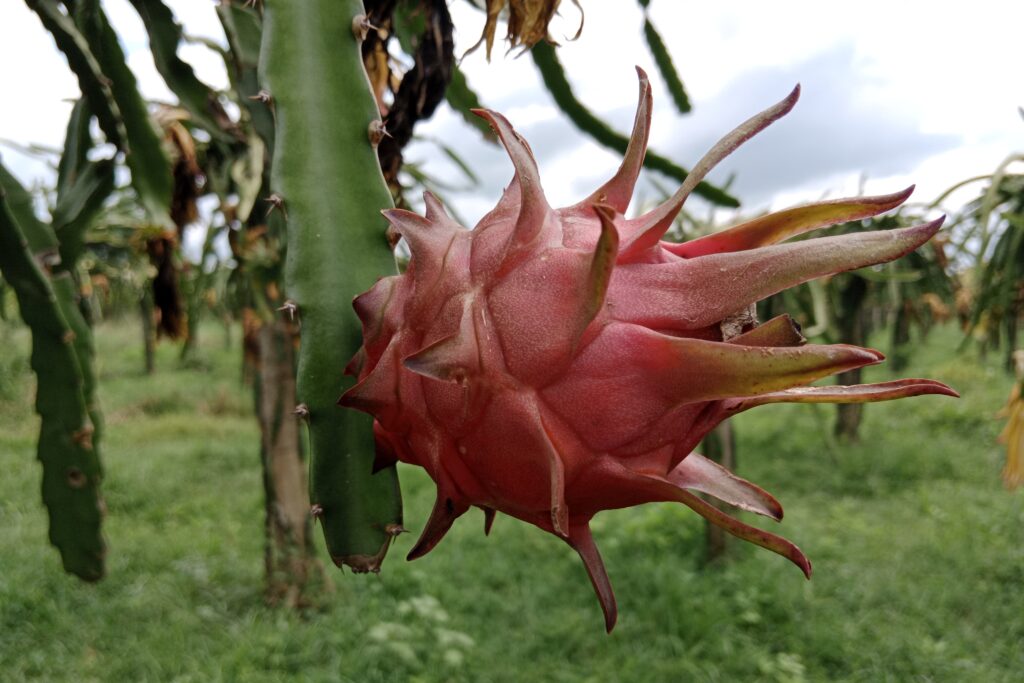Arugula Farming
Arugula (Eruca vesicaria subsp. sativa), often called rocket or salad rocket, is a quickly maturing, nutrient-dense leafy green belonging to the Brassicaceae family. Known for its sharp, peppery taste with a hint of nuttiness, it is widely used in salads, sandwiches, and as a garnish.
Rich in vitamins A, C, and K, as well as key minerals like calcium and iron, arugula is well-suited for both home gardening and commercial cultivation due to its short growth cycle and ability to thrive in various climates.
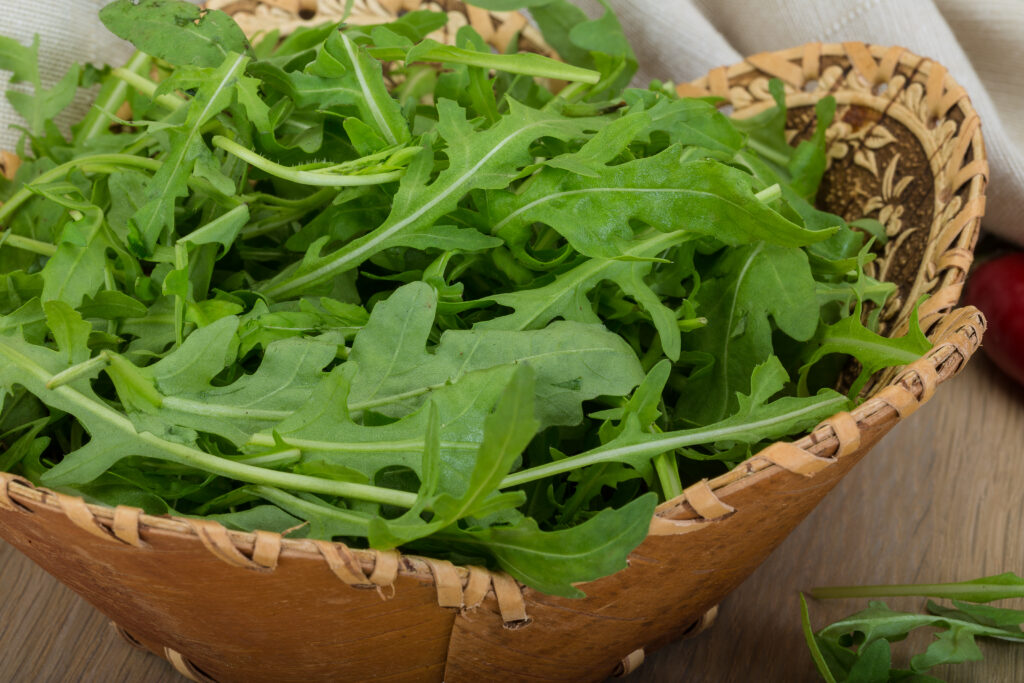
Arugula farming profit per acre demonstrates significant potential, exemplified by a net profit of NRs. 173,000 per acre. This profitability stems from an average yield of 4,500 kg commanding a market price of NRs. 50 per kg.
While major expenses include land preparation, fertilizers, and nursery management, costs associated with harvesting, irrigation, and pest management are comparatively moderate. Crucially, arugula’s short growing cycle—just 3–6 weeks for baby leaf and up to 55 days for full-size—enables multiple cropping cycles annually, substantially boosting overall annual returns.
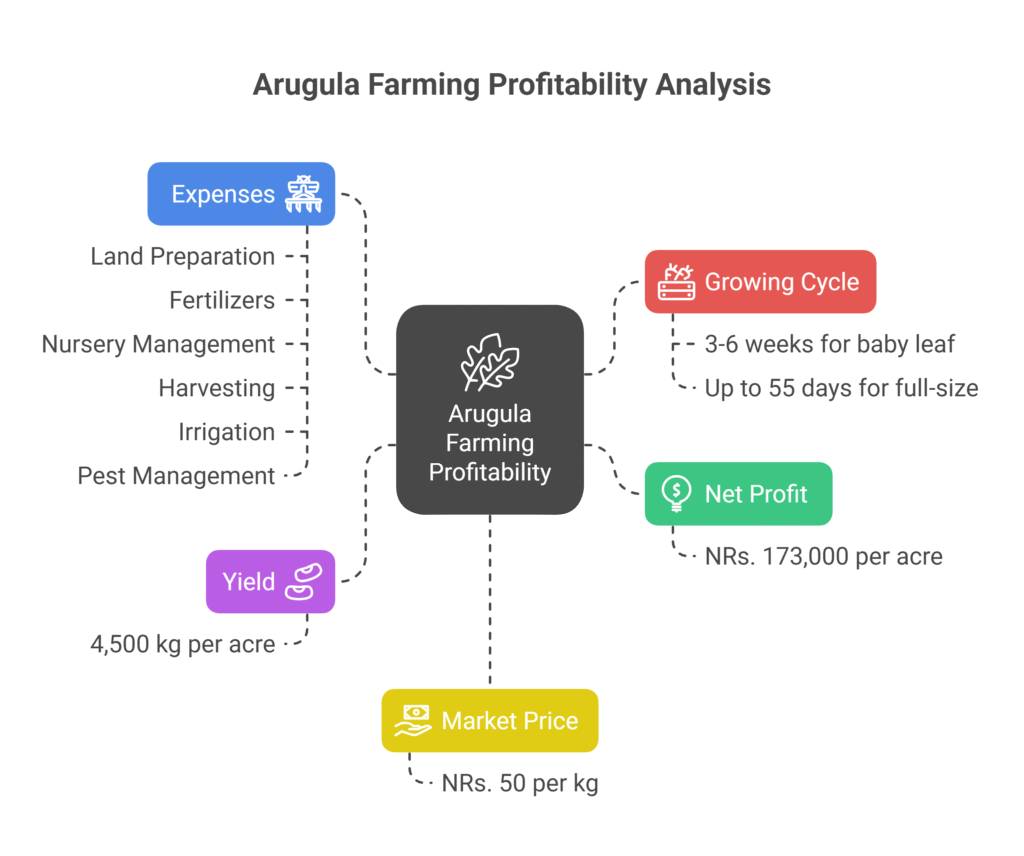
Land Preparation
For arugula cultivation, the land should be cleared of weeds, crop residues, and debris, then plowed or rotovated to a depth of 20–30 cm to loosen the soil and improve aeration and drainage. Subsequent harrowing or disking helps break down clods and create a fine tilth suitable for seed germination.
Incorporating well-decomposed organic matter or compost during preparation enhances soil fertility and structure, while raised beds or leveled surfaces ensure proper drainage and ease of management. A well-prepared seedbed promotes uniform germination, healthy root development, and vigorous crop growth.
Soil Type
The most suitable soils for arugula cultivation are loamy, rich in organic matter, and well-drained, with a slightly acidic to neutral pH between 6.0 and 7.0. While the crop can also grow in sandy or clay soil if drainage is sufficient, excess moisture and poor drainage should be avoided as they hinder root growth and raise the risk of diseases.
The addition of compost or decomposed organic matter helps improve soil fertility and texture, encouraging healthy plants and tender leaves.
Climatic Requirements
Arugula is a cool-season leafy vegetable that thrives best in mild climates with temperatures ranging between 10–24°C. It prefers cool weather for rapid growth and good leaf quality, as excessive heat can cause premature bolting and bitter flavor.
While it can tolerate light frosts, prolonged high temperatures reduce yield and quality. For optimal production, arugula is usually grown in early spring or fall when conditions are cool and favorable.

Major Cultivars
When selecting cultivars, it is important to consider traits such as flavor intensity, leaf size, bolt resistance, and regional adaptability.
Common or wild arugula has narrower, deeply serrated leaves with a stronger, peppery flavor and tends to bolt more slowly, while cultivated or salad arugula features broader, rounded leaves, a milder taste, and faster growth, making it more popular commercially.
Among cultivated types, varieties like ‘Astro’ and ‘Apollo’ are preferred for their mild flavor, while ‘Runway’ and ‘Slow Bolt’ are valued for their resistance to premature bolting.
Propagation
Arugula is propagated exclusively by seed, either through direct sowing in the field or, less commonly, by starting seeds in modules for later transplanting, particularly when not grown for baby leaf production. The seeds are small, round, and usually light brown in color.
Seed Rate per Acre
| Production Type | Seed Rate per Acre | Notes |
| Baby Leaf Production (Cut-and-Come-Again) | 3.6–5.4 kg | High density planting for multiple harvests |
| Full-Size/Bunched Production | 0.9–1.8 kg | Lower density planting to allow plants to size up |
Nursery Management
Nursery management for arugula is less common since direct seeding is generally preferred for efficiency, but transplanting may be practiced in very early seasons or controlled environments. Seeds are sown in plug trays with 128 or 200 cells filled with sterile seed-starting mix, placing 1–2 seeds per cell at a depth of about 0.5 cm.
Consistent moisture and temperatures of 15–20°C should be maintained, and seedlings are thinned to one per cell after germination. Before field planting, seedlings are hardened off for 5–7 days and transplanted once they develop 3–4 true leaves.
Planting
Planting Season
The planting season for arugula extends from August to December.
Spacing
For spacing, baby leaf arugula is either broadcasted or sown in dense bands 5–8 cm wide with rows 10–15 cm apart, while full-size or bunched production is planted in rows 30–45 cm apart, with seedlings thinned to 10–15 cm apart within the row after germination.
Planting Method
Direct Seeding
Direct seeding is the most common method for growing arugula. Seeds should be sown 0.5–1 cm deep. They can either be broadcast over the prepared soil and lightly raked in to ensure good soil contact or precision seeded in rows using a push seeder or mechanical planter for more uniform spacing and growth.
Transplanting
Transplanting is less common but may be used for full-size production or in early-season plantings. Hardened-off seedlings are carefully set into the field at the desired spacing. After transplanting, seedlings should be watered thoroughly to help them establish quickly and reduce transplant shock.
Number of Plants per Acre
| Production Type | Number of Plants per Acre |
| Baby Leaf | 500,000 – 1,000,000+ |
| Full-Size/Bunched | 60,000 – 135,000 |
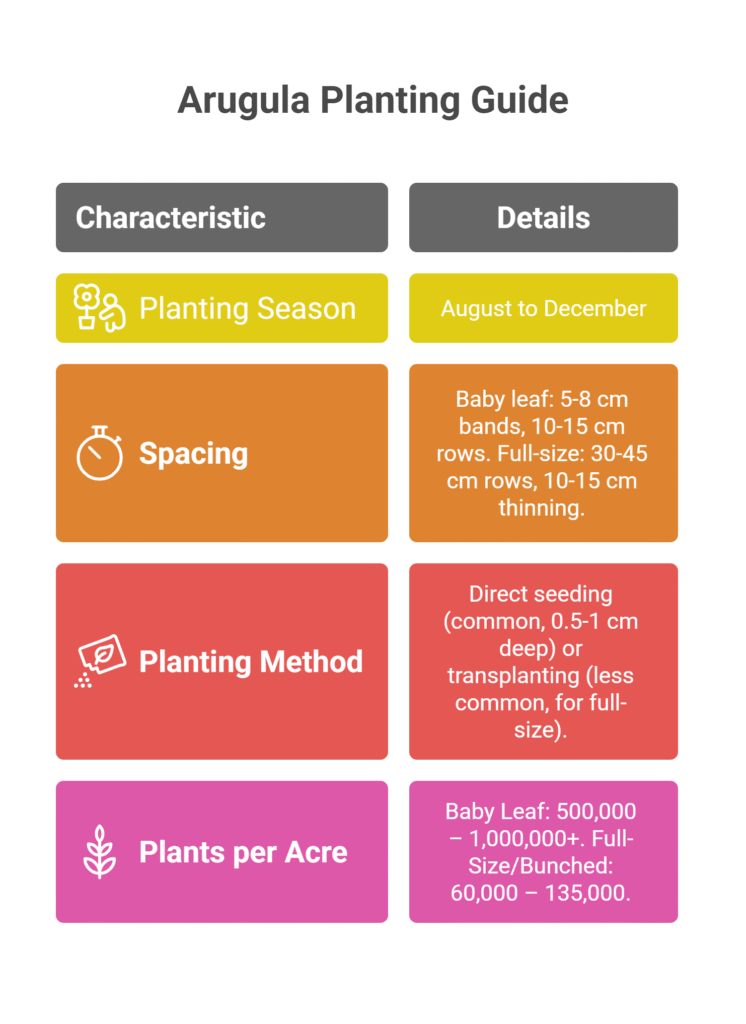
Intercropping
Arugula can be effectively intercropped with slower-maturing vegetables such as tomatoes, peppers, and other brassicas, or planted along bed edges. This approach maximizes space, helps suppress early weeds, and provides ground cover. However, it is important to ensure that arugula is not shaded out by the companion crops as they grow and to manage competition for water and nutrients to maintain healthy growth.
Irrigation
Consistent soil moisture is critical for arugula, as water stress can lead to bitterness and premature bolting. Drip irrigation is ideal because it conserves water, keeps foliage dry to reduce disease, and delivers water precisely, while overhead sprinklers are acceptable but may increase disease risk; flooding should be avoided.
Light, frequent irrigations are recommended, particularly in sandy soils or warm weather, aiming for about 2.5–3.5 cm per week, adjusted for rainfall, soil type, and temperature, ensuring the soil remains consistently moist but not waterlogged.
Fertilizer and Manure
To find out which particular nutrients and amendments are required for the best arugula growth, a soil test must be performed.
| Fertilizer Type/Stage | Application Details | Purpose/Notes |
| Organic Matter | 10-15 tons/acre of well-decomposed compost or manure before planting. | Crucial for improving soil structure, moisture retention, and providing slow nutrient release. |
| Biofertilizers | 500g per acre each of: – Azospirillum – PSB (Phosphate Solubilizing Bacteria) – Potash mobilizing bacteria | Apply during soil preparation or planting. |
| Basal Fertilizer | 18-27kg N per acre equivalent of a balanced NPK fertilizer (e.g., 10-10-10) during bed preparation or planting. | Higher nitrogen promotes vigorous leafy growth. Adjust P & K based on soil test. |
| Side Dressing (Optional) | Apply a light side-dressing of nitrogen (e.g., blood meal, compost tea, soluble N fertilizer) 2-3 weeks after emergence or after the first cut. | Boosts regrowth for long-season or multiple-cut crops. AVOID over-fertilization (causes nitrate accumulation & weak growth). |
Weed Control
Weed control is critical for arugula, as weeds compete aggressively with the fast-growing crop. Cultural methods include the stale seedbed technique, where weeds are allowed to germinate before planting and then removed by flaming or shallow hoeing, dense planting to shade out weeds (especially in baby leaf production), and crop rotation.
Mechanical control involves careful hand weeding or shallow hoeing when weeds are small, since arugula roots are shallow and easily damaged.
Mulching with organic materials like straw or compost, or using biodegradable plastic mulch, effectively suppresses weeds and conserves moisture when applied after seeding or transplanting.
Chemical control options include cautiously using pre-emergent herbicides labeled for leafy greens in commercial production, while post-emergent herbicides are limited due to crop sensitivity and short harvest windows; organic herbicides, such as vinegar-based solutions, can also be used for spot treatments.
Flowering Management
Flowering, or bolting, in arugula is mainly triggered by increasing day length and temperatures above the optimal range, and it is undesirable for leaf production because leaves become small, tough, and intensely bitter.
To manage bolting, growers should select bolt-resistant cultivars such as ‘Runway’ or ‘Slow Bolt,’ plant during the appropriate cool season, use shade cloth during warm periods, maintain consistent moisture, and harvest promptly.
If flowering stalks begin to appear, the entire plant should be harvested immediately for any usable leaves, as pinching off flower stalks is largely ineffective and only minimally delays harvest.
Pest and Disease Management
Common Pests
Flea Beetles
Flea beetles are one of the most common pests of arugula, creating numerous small shot holes in the leaves. Use floating row covers at planting to prevent early infestation.
Organic sprays such as neem oil at 2–3 ml per liter of water, spinosad at 0.5–1 ml per liter, or pyrethrin at 0.2–0.5 ml per liter can be applied, ensuring thorough coverage of leaves. Encouraging beneficial insects like predatory beetles and lacewings helps maintain natural control.
Aphids
Aphids harm crops and may spread disease by congregating on the undersides of leaves and sucking plant sap. Neem oil (two to three milliliters per liter), insecticidal soap (5 to ten milliliters per liter of water), or a powerful water jet can be used to dislodge plants. Beneficial insects that are natural predators include lacewings and ladybugs.
Cabbage Loopers/Imported Cabbage worms
These caterpillars chew large holes in the leaves. Bacillus thuringiensis (Bt) should be applied at 2–3 g per liter of water, ensuring thorough leaf coverage. Hand-picking larvae is also effective for small infestations. Spinosad can be used at 0.5–1 ml per liter as an alternative.
Slugs and Snails
Slugs and snails create irregular holes in leaves, especially in damp conditions. Management includes traps such as beer traps, iron phosphate bait applied according to label instructions (typically 5–10 g per square meter), spreading diatomaceous earth around plants, and hand-picking at night when they are most active.
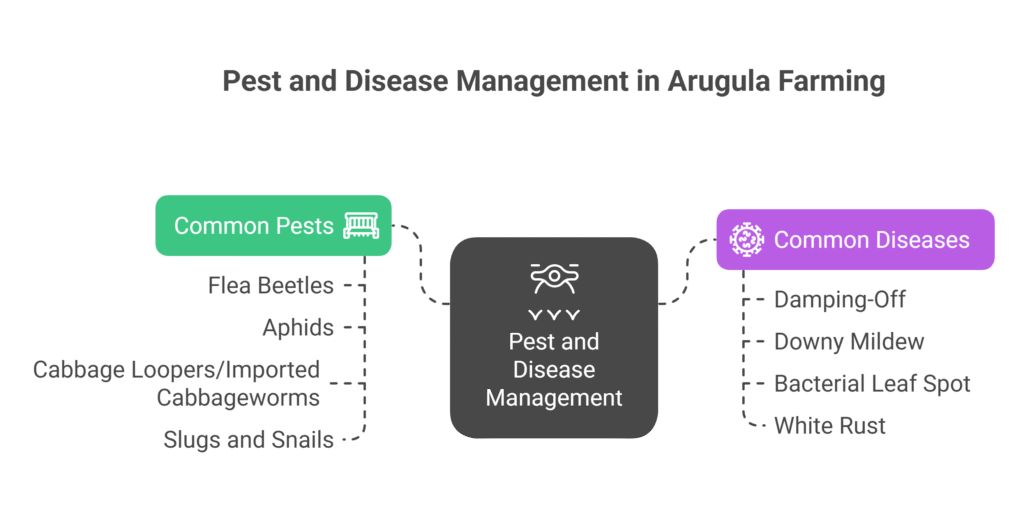
Common Diseases
Damping-Off
Damping-off affects seedlings and is caused by soil-borne fungi, leading to seedling collapse and poor emergence. Prevention is key—use well-drained soil or sterile seed-starting mix and avoid overwatering to reduce fungal development. Fungicides are generally not required if good cultural practices are followed.
Downy Mildew
On the upper leaf surface, downy mildew manifests as yellow patches, but on the underside, it grows fuzzy and grayish. It thrives in damp, chilly weather. Increasing air circulation, minimizing overhead watering, and cultivating resistant cultivars are all examples of management.
To ensure complete coverage, fungicidal sprays, such as potassium phosphite at 2-3 ml per liter or copper oxychloride at 2-3 g per liter of water, can be sprayed either as a preventative measure or as soon as an infection appears.
Bacterial Leaf Spot
This disease causes angular, water-soaked spots that turn brown or black. To manage it, avoid overhead watering, practice crop rotation, and remove infected plant debris. Copper-based sprays, such as copper hydroxide at 2–3 g per liter, can help reduce bacterial spread when applied carefully, preferably in the early morning or evening to prevent leaf burn.
White Rust (Albugo candida)
White pustules on the undersides of leaves and yellow dots on the upper surface are signs of white rust. Removing sick plant material, rotating crops, and cultivating resistant cultivars are examples of management techniques.
In order to stop the spread of the disease, systemic fungicides designated for white rust or fungicidal treatment with copper oxychloride at a rate of 2-3 g per liter can be applied as soon as symptoms appear. This should be repeated as directed on the product label.
Harvesting
Timing of Harvest
For baby leaf production, arugula can be harvested 21–35 days after sowing. Leaves should be cut when they are 2.5–7.5 cm long, leaving 2–5 cm of stem above the crown to allow regrowth. Multiple harvests are possible, usually 2–4 cuts at intervals of 10–21 days.
For full-size or bunched production, harvest occurs 40–55 days after sowing. Whole rosettes can be cut just below the crown when leaves reach 10–15 cm long, before bolting, or larger outer leaves can be harvested individually over time.
Harvesting Method
Hand harvesting using sharp knives or scissors is recommended to minimize damage to the plant and leaves. Early morning is the ideal time for harvest, as leaves are crisp and the field temperature is cooler, helping maintain quality.
Post-Harvest Handling
Immediately after harvest, leaves should be cooled rapidly using hydro-cooling or forced-air cooling to 0–2°C to remove field heat. Leaves should be washed carefully in clean, cold water, with sanitization if necessary, and gently spin-dried. Packing can be done in perforated bags or clamshells.
It is important to maintain a cold chain at 0–2°C with 90–95% relative humidity throughout storage and transportation. The optimal shelf life of arugula is short, typically 10–14 days.
Yield
The average yield of arugula ranges from approximately 3,600 to 6,800 kg per acre, depending on variety, cultivation practices, and growing conditions.
Cost of Investment Per Acre for Arugula
| S.N. | Categories | Cost for Investment (NRs.) |
| 1 | Land Preparation (Plowing) | 15,000 |
| 2 | Seed | 2,500 |
| 3 | Nursery Management | 5,000 |
| 4 | Transplanting | 3,000 |
| 5 | Fertilizers and Manure | 7,000 |
| 6 | Irrigation | 5,000 |
| 7 | Weed Control (Pre & Post-emergence) | 2,000 |
| 8 | Pest & Disease Control | 3,000 |
| 9 | Harvesting | 4,500 |
| 10 | Miscellaneous Costs | 5,000 |
| Total Cost | 52,000 |
Income per acre from Arugula Farming
| Particulars | Estimated Yield (Kg/Acre) | Market Price (NRs/kg) | Total Income (NRs.) |
| Arugula Yield | 4,500 | 50 | 225,000 |
Analysis of Arugula Farming Profit Per Acre
Arugula farming per acre shows a high profit potential, with a net profit of NRs. 173,000 per acre based on an average yield of 4,500 kg and a market price of NRs. 50 per kg. The major cost components are land preparation, fertilizers, and nursery management, while harvesting, irrigation, and pest management are relatively moderate. Given its short growing cycle (3–6 weeks for baby leaf and up to 55 days for full-size), multiple cropping cycles per year can significantly increase annual returns.
Crop Calendar for Arugula Farming
| Stage | Timing | Key Activities |
| Land Preparation | 1–2 weeks before sowing | Deep plowing (15–20 cm), soil amendment (10–15 tons compost/acre), bed formation (raised beds if heavy soil). |
| Sowing | Cool seasons (Aug–Dec) | Direct seeding: 0.5–1 cm depth. Baby leaf: 8–12 lbs/acre (broadcast). Full-size: 2–4 lbs/acre (rows 30–45 cm apart). |
| Germination | Days 3–7 | Maintain soil moisture (drip irrigation), protect from pests (row covers). |
| Early Growth | Weeks 1–3 | Thinning (full-size: 10–15 cm between plants), weed control (mulching/shallow hoeing), light N application if needed. |
| Active Growth | Weeks 3–6 | Irrigation: 2.5–3.5 cm/week (adjust for soil/weather). Pest/disease monitoring: Flea beetles, aphids, downy mildew. Apply neem/Bt if needed. |
| Baby Leaf Harvest | Weeks 3–6 | First cut at 21–35 days (leaves 2.5–7.5 cm). Cut 2–5 cm above crown. |
| Full-Size Harvest | Weeks 6–8 | Harvest at 40–55 days (leaves 10–15 cm). Cut whole rosettes or outer leaves. |
| Post-Harvest | Immediately after cut | Rapid cooling (0–2°C), gentle washing, spin-drying, perforated bag packaging. |
| Regrowth (Baby Leaf) | Post-harvest | Light N side-dressing, irrigation, weed control. Next cut in 10–21 days. |
Sources
Food and Agriculture Organization (FAO)
University of California Agriculture & Natural Resources (UC ANR)
European Plant Protection Organization (EPPO)
Punjab Agricultural University (PAU)
Tamil Nadu Agriculture University (TNAU) – Agritech portal
Indian Council of Agricultural Research (ICAR)
Nepal Agricultural Research Council (NARC)
U.S. Department of Agriculture (USDA).
Disclaimer: This crop farming profits assume optimal conditions. Actual results may vary depending on climate, market prices, and farm management practices.

